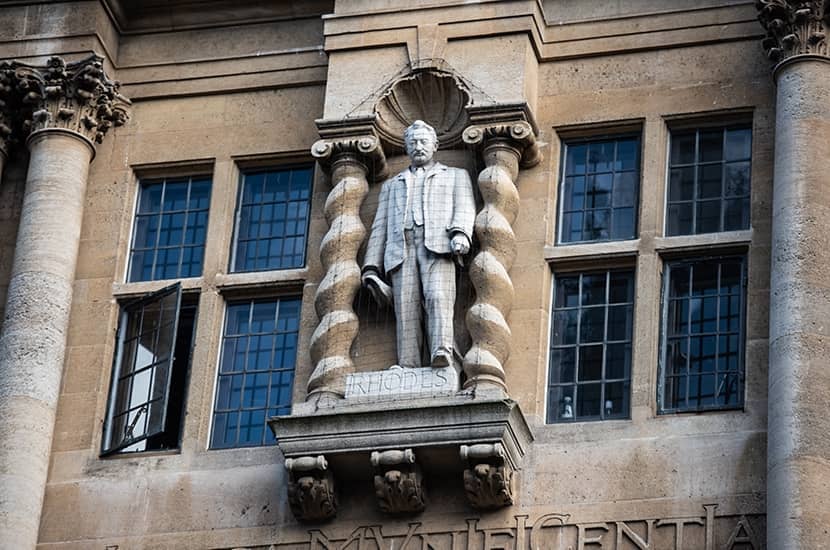I’m sympathetic to Oliver Dowden’s formula for defusing culture-war disputes about statues of controversial historic figures: ‘retain and explain’. That is, don’t pull statues down, but make it clear that their remaining in place doesn’t signify approval of everything the people they represent did. Provide the public with a helpful summary of their lives and works, the good as well as the bad, so we can make a rounded assessment and, hopefully, judge them by the standards of their times as well as of our own.
Unfortunately, the ‘explanatory panel’ that has just appeared beneath the statue of Cecil Rhodes on the facade of Oriel college falls somewhat short of this ideal. It describes him as a ‘committed British colonialist’ who ‘obtained his fortune through exploitation of minerals, land, and peoples of southern Africa’. In case you’re in any doubt about how terrible he was, it adds: ‘Some of his activities led to great loss of life and attracted criticism in his day and ever since.’
The plaque reads like an invitation to Rhodes Must Fall protestors to take matters into their own hands
The problem with this summary isn’t that it’s historically inaccurate, but that it’s too one-sided. Yes, Rhodes was a committed colonialist, but he also campaigned against withholding voting rights from the indigenous peoples of the Cape Colony provided they met the same eligibility criteria as whites. He funded a newspaper, Izwi labantu, aimed at an African readership and which, after his death, played a pivotal role in the formation of the African National Congress. Most significantly, he inserted a clause in his will making it clear that the scholarships bearing his name should be awarded without regard to race. For staunch defenders of imperialism, that was tantamount to heresy.
No doubt there wasn’t room on the panel to include the case for the defence as well as the prosecution and, to be fair, it includes a QR code directing you to a page on Oriel’s website that offers a slightly more nuanced discussion of Rhodes’s shortcomings and includes a dissenting opinion by Professor Nigel Biggar. But what’s lacking is any sense that the college subscribes to the ‘retain and explain’ principle. On the contrary, reading the plaque’s damning summary would leave any casual passer-by puzzled as to why the statue hasn’t been pulled down. (According to the Cambridge historian David Abulafia, the summary of the message is: This is a statue of the devil incarnate.) Indeed, the college makes it clear that this is what it wanted, but that it has been frustrated in its desire to erase Rhodes from history. The final sentence reads: ‘In June 2020, Oriel college declared its wish to remove the statue but is not doing so following legal and regulatory advice.’
Isn’t that a tad irresponsible in light of what happened to the statue of Edward Colston in Bristol last year? The plaque reads like a gold-embossed invitation to Rhodes Must Fall protestors to take matters into their own hands. ‘We’d like nothing more than to tear the statue down,’ it seems to say. ‘But we can’t because the pesky authorities won’t let us. Student activists, over to you.’
Maybe I’m being too harsh. I daresay the college’s governing body doesn’t actually want protestors to vandalise their building, and the reason they haven’t a word to say in favour of Rhodes is that they don’t want to be accused of making excuses for colonialism. To suggest that the British empire did some good in the world as well as bad, or that some imperialists were well-intentioned Christians rather than rapacious capitalists, is verboten in contemporary academia. When Nigel Biggar said those things four years ago he was immediately denounced in ‘open letters’ by his colleagues. The words on the Rhodes plaque merely reflect the fact that what was once a safe haven for maverick historians is now an ideological minefield in which anyone who challenges the orthodoxy risks blowing up their career.
This points to a wider difficulty with the ‘retain and explain’ approach: it’s a compromise that hasn’t been accepted by the would-be ‘-cleansers’ of Britain’s colonial past. If the government forces the custodians of statues and monuments to keep them against their will, whether by threatening to withdraw funding or pointing out the legal and regulatory complexities of removing them, those custodians will ‘retain and denounce’ rather than make a good-faith effort to contextualise the historical figure in question. It’s preferable to throwing the statue of Rhodes into the river Cherwell, I suppose, but it does little to reduce hostilities in the culture war.







Comments